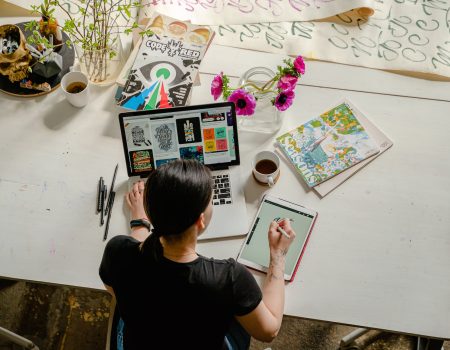Choosing the Right Canvas Size
When it comes to creating art, choosing the right canvas size can make all the difference. Whether you’re painting with oils or acrylics, or in our case using digital art, the right canvas size can help your artwork stand out and make an impact. There are several factors to consider when choosing the right canvas size, including the style of your digital artwork. In with digital art software was it made is a good quesdotn to ask for example.
In this blog, we will discuss how to understand canvas sizes, ideal procreate canvas sizes, and how to enhance your artistic vision with the perfect canvas dimensions.
We will also talk about common mistakes and what not to do.

Understanding Canvas Sizes
To better understand canvas sizes you must understand the difference between pixels and inches and resolution and DPI.
Pixels, the more pixels you have the more details your image will portray. Its important to pick the right size otherwise you might loose the quality of your artwork
On the other hand, inches are commonly used to specify the size of printed materials, such as photographs, posters, and documents. Extremely important if you want hight quality print.
However, the relationship between pixels and inches depends on the resolution of the digital image and the size at which it is printed.
So, we come to the question of what is resolution exactly? Well, it is the amount of details that you can find in an image. That is to say the overall clarity. Resolution is in fact crucial for digital displays and is often used to describe the quality of digital images. Like for example, those displayed on computer screens or smartphones.
Now we have to mention DPI to better understand the canvas sizes. The DPI or (dots per inch), is a measure of the printing resolution or the density of dots in a printed image. Therefore a high DPI will result in a more detailed print.
Procreate Canvas Sizes

Most importantly, procreate offers a variety of canvas sizes to choose from, each with unique dimensions to suit different needs. Like for example, illustrations, graphic design or digital art work, like painting. It depends on what you want to use it for. See more tips and tricks of procreate.
So, whether you’re working on a small-scale project or a large-scale piece, Procreate has a canvas size that can accommodate your vision. Some of the most popular canvas sizes include square, portrait, and landscape orientations. Each with different dimensions to ensure that your final piece looks as intended.
Additionally, Procreate allows you to customize your canvas size to fit your specific needs, ensuring that you have complete control over the dimensions of your digital canvas. With Procreate’s diverse range of canvas sizes, you can create artwork that is precisely tailored to your vision.
Ideal Canvas Size for Procreate
So more importantly, procreate offers a range of canvas sizes to accommodate various types of artwork, from sketches and illustrations to digital paintings and designs. One can say that the ideal canvas size depends on factors such as the intended use of the artwork, the level of detail desired, and personal preferences.
Let’s look at some Procreate canvas sizes and their recommended uses:
Screen Sizes:
- 2048 x 2732 pixels (12.9-inch iPad Pro): This canvas size is suitable for creating artwork directly on an iPad Pro with a large screen. It offers ample space for detailed illustrations, digital paintings, and designs.
- 1668 x 2224 pixels (11-inch iPad Pro): Similar to the larger iPad Pro size, this canvas size is ideal for creating artwork on the 11-inch iPad Pro model.
Print Sizes:
- 3000 x 3000 pixels (10 x 10 inches at 300 DPI): This canvas size is suitable for creating artwork intended for printing at a medium size, such as art prints, posters, or greeting cards.
- 4500 x 5400 pixels (15 x 18 inches at 300 DPI): For larger prints or artworks with more intricate details, this canvas size provides higher resolution and more space for creativity.
Social Media Sizes:
- 1080 x 1080 pixels (Square): Ideal for creating artwork for social media platforms like Instagram, where square images are commonly used for posts or profile pictures.
- 1080 x 1920 pixels (Vertical): Suitable for creating artwork for Instagram Stories or other platforms that favor vertical orientation.
Custom Sizes:
- Procreate allows you to create custom canvas sizes to fit your specific needs. Whether you’re working on a unique project or require dimensions tailored to a particular display or printing requirement, custom canvas sizes offer flexibility and versatility.
When choosing a canvas size in Procreate, consider factors such as the level of detail you want to achieve, the intended display or printing format, and any specific requirements for the project. Experimenting with different canvas sizes can help you find the ideal dimensions for your artwork and creative process.
Additionally, Procreate’s seamless integration with iPad devices provides a responsive and intuitive drawing experience across various canvas sizes. Extremely easy to understand rendering in digital art
Enhancing Your Artistic Vision with the Perfect Canvas Dimensions
Enhancing your artistic vision with the perfect canvas dimensions involves considering various factors such as the subject matter, composition, intended display location, and personal preferences. Here is where you can add your own touch to your art.
Here’s are some ways that you can use enhance your artistic vision.
1. Consider the subject matter: Well, of course, the subject of your artwork can influence the ideal canvas dimensions. For example, a landscape painting might benefit from a wide horizontal canvas to capture the expansive scenery, while a portrait might require a taller vertical canvas to emphasize the subject’s height.
2. Think about composition: You should visualize how you want to compose your artwork and how different canvas dimensions can enhance or detract from the composition. Consider elements such as focal points, balance, and negative space when choosing the canvas size.
3. Reflect on Display Location: For instance, if you have a specific location in mind for displaying your artwork, consider the available space and how different canvas dimensions will fit within that space. After all, a large wall may accommodate a statement piece with expansive dimensions, while a smaller space may require a more compact canvas.
4. Explore Standard Sizes and Ratios: Standard canvas sizes and aspect ratios can provide a starting point for selecting dimensions. Common aspect ratios include 4:3, 3:2, and 16:9, which correspond to typical photo and screen dimensions. Standard sizes range from small squares to large rectangles, offering a variety of options to suit different artistic visions.
Experiment With Custom Sizes
5. Experiment with Custom Sizes: Don’t feel limited by standard canvas sizes—consider customizing the dimensions to fit your artistic vision. Many art supply stores offer custom canvas stretching services, allowing you to create a canvas tailored to your specific needs.
6. Account for Frame and Matting: If you plan to frame your artwork, remember to account for the frame’s dimensions when selecting the canvas size. Additionally, if you prefer to add matting around the artwork, consider how this will affect the overall presentation and choose canvas dimensions accordingly.
7. Trust Your Intuition: Ultimately, trust your artistic instincts and preferences when choosing canvas dimensions. Select dimensions that feel intuitively right for expressing your vision and conveying the desired impact to viewers.
By considering these factors and experimenting with different canvas dimensions, you can enhance your artistic vision and create artwork that is both visually compelling and emotionally resonant.
Common Mistakes
Choosing the right canvas size for your digital art is crucial for achieving the desired outcome. So you will have to try to avoid a certain number of things. The most important one being, choosing arbitrary sizes. With that I mean choose canvas sizes randomly instead of actually looking at the details.
The second most common mistake is ignoring resolution. This will result in a loss of quality, especially when printed.
However, some people make the mistake of overestimating the need for details. While higher resolution canvases allow for more detail, they can also increase file size and processing requirements.
Ignoring Aspect Ratio
Do not ignore the aspect ratio as this will have bad consequences on your digital artwork. Of course this refers to the proportional relationship between the width and height of the canvas. Therefore, ignoring aspect ratio considerations can lead to distortion or cropping of the artwork when displayed on different devices or platforms.
A lot of my customers tend to forget about margins and bleed. Thinking that they can use the entire paper and not worry about where the artwork will be cut. When creating artwork for printing, remember to account for margins and bleed areas to ensure that important elements are not cut off during the printing process. Most of all, leaving insufficient space for margins and bleed can result in unintended cropping or trimming of the artwork.
The last common mistake that I am going to mention is not testing different sizes. This is of course crucial before committing to a specific canvas size. Most of all, you need to consider testing your artwork on different canvas sizes to see how it affects the composition and overall look. Experimenting with various sizes can help you find the optimal dimensions for your digital art.
Last Few Words
When creating your digital art, the perfect canvas size is real important. Just like the optimal logo dimensions are crucial for custom logos. Also, it’s equally essential to take the resolution into account for optimal results. All you have to do is to understand what pixels, inches, DPI and resolution all means to you and how every aspect of your digital art work should be portrayed int the way you want it. Therefore, it’s imperative to choose wisely and carefully. Good luck!
